Bruce Frantzis | |
|---|---|
 | |
| Born | April 1949 |
| Occupation(s) | Tai Chi, Meditation and Qigong Teacher and Author |
| Known for | Taoist Lineage Master (Liu Hung-Chieh) |
Bruce Kumar Frantzis (born April 1949) is a Taoist educator who studied Taoism in China.
Bruce Frantzis | |
|---|---|
 | |
| Born | April 1949 |
| Occupation(s) | Tai Chi, Meditation and Qigong Teacher and Author |
| Known for | Taoist Lineage Master (Liu Hung-Chieh) |
Bruce Kumar Frantzis (born April 1949) is a Taoist educator who studied Taoism in China.
Beginning as a young karate champion, he engaged in a multi-decade journey leading him throughout Asia and the Eastern energetic traditions. [1] [2] Choosing to forgo an ivy league education in favor of pursuing Japanese martial arts at their original source, he moved to Japan to attend Sophia University at the age of eighteen. [3] There, he obtained multiple black belts and trained with Aikido’s founder Morihei Ueshiba. [4] He soon branched out to Taiwan and China and studied in increasing depth under internal martial arts masters. [5] [6]
In 1973, attempting to locate the original source of meditation, Bruce traveled to India where he underwent rigorous daily training in Pranayama, Hatha yoga, Raja yoga and Tantra with many Gurus, experiencing what in the east is known as “Kundalini Shakti”. [7]
Returning to China in the mid 1970s, he became the first Westerner to be given insider access to the closely guarded Taoist Fire tradition (unverified tradition) and its priesthood. [8] After completing seven years of training he became priest in the Fire tradition. [9] Then by a fortunate set of events Bruce was accepted as the direct disciple of one of the few remaining stewards of the Water tradition (unverified tradition), the Taoist Immortal (Fully Realized Person) Liu Hung-Chieh. [10] Through Liu Hung-Chieh he was introduced to Jiang Jia Hua the Vice President of the All-China Scientific Qigong Association. This connection gave Bruce access to Chinese cancer clinics where he completed his training as Medical Qigong doctor. [11]
Bruce inherited the Taoist Water tradition lineages shortly before Liu-Hung Chieh’s passing in 1986. On his teacher’s wishes he has spent the last 25 years imparting the healing, meditative and martial aspects of Taoism to the West. [12] He primarily teaches the Energy Arts qigong System, Wu-style tai chi, bagua , Taoist yoga and Taoist meditation. He has authored numerous works (including The Power of the Internal Martial Arts and Chi, Tao of Letting Go, Dragon and Tiger Medical Qigong, and Opening the Energy Gates of Your Body) on Taoist energetic practices [13] and taught over 20,000 students many of whom have gone on to become active certified instructors. [14]
Additionally, he is a regular participant in the Tibetan Buddhist community, a process that began with his training under Dudjom Rinpoche in 1976. He is an active student of Dzogchen, an advanced tradition he considers to share a common origin with the Taoist water tradition. Currently Bruce’s teaching focus has shifted towards healing and meditation in accordance with his late teacher’s final wishes. [15] [16]

Neijia is the collective name for the internal Chinese martial arts. It relates to those martial arts occupied with spiritual, mental or qi-related aspects, as opposed to an "external" approach focused on physiological aspects. The distinction dates to the 17th century, but its modern application is due to publications by Sun Lutang, dating to the period of 1915 to 1928. Neijin is developed by using neigong or "internal changes", contrasted with waigong or "external exercises".

Tai chi is an internal Chinese martial art practiced for self-defense and health. Known for its slow, intentional movements, tai chi has practitioners worldwide and is particularly popular as a form of gentle exercise and moving meditation, with benefits to mental and physical health.
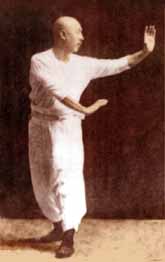
Baguazhang is one of the three main Chinese martial arts of the Wudang school, the other two being tai chi and xingyiquan. It is more broadly grouped as an internal practice. Baguazhang literally means "eight trigram palm", referring to the bagua "trigrams" of the I Ching, one of the canons of Taoism.

Chinese martial arts, often called by the umbrella terms kung fu, kuoshu or wushu, are multiple fighting styles that have developed over the centuries in Greater China. These fighting styles are often classified according to common traits, identified as "families" of martial arts. Examples of such traits include Shaolinquan (少林拳) physical exercises involving All Other Animals (五形) mimicry or training methods inspired by Old Chinese philosophies, religions and legends. Styles that focus on qi manipulation are called internal, while others that concentrate on improving muscle and cardiovascular fitness are called external. Geographical associations, as in northern and southern, is another popular classification method.

Liuhebafa quan is an internal Chinese martial art. It has been called "xinyi liuhebafa" (心意六合八法拳) and is also referred to as "water boxing" due to its principles.

Dantian is a concept in traditional Chinese medicine loosely translated as "elixir field", "sea of qi", or simply "energy center". Dantian are the "qi focus flow centers", important focal points for meditative and exercise techniques such as qigong, martial arts such as tai chi, and in traditional Chinese medicine.
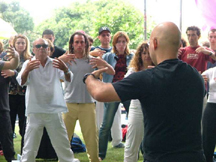
Zhan zhuang is a training method often practiced by students of neijia, such as yiquan, xingyiquan, baguazhang and tai chi. Zhan zhuang is sometimes translated Standing-on-stake, Standing Qigong, Standing Like a Tree, Post-standing, Pile-standing, or Pylon Standing.
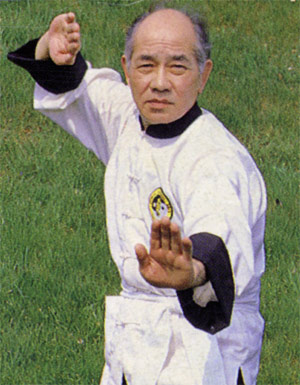
The Lee style of tai chi (李氏太極拳) is closely related to a range of disciplines of Taoist Arts taught within the Lee style including Qigong, Daoyin, Ch'ang Ming, Traditional Chinese Medicine, Taoist alchemy, Feng Shou kung fu, and weapons practice. According to practitioners, it was first brought to the West in the 1930s by Chan Kam Lee and was subsequently popularized by Chee Soo who was the President of the International Taoist Society from 1958 until his death in 1994. The Lee style of tai chi comprises two forms known as 'the dance' and 'the form'. Other exercises include Yifu Shou or 'sticky hands', Whirling Hands, Whirling Arms, and various qi and Li development exercises. Lee style t'ai chi is related to Martial Arts training, and there are five distinct areas of development that comprise the whole Art:
Reverse breathing is a breathing technique associated with qigong and martial arts. It consists of compressing the abdomen while inhaling through the mouth, and expanding it while exhaling through the nose. Practitioners believe that consciously controlling this movement in a way opposite to normal breathing can build up qi for various applications.
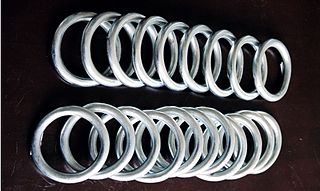
Ziranmen, also known as Natural Boxing, is a Northern internal style of kung fu that is taught in conjunction with qigong breathing techniques. The style traces its lineage to Dwarf Xu, who based it on ancient Taoist philosophy. Du Xinwu, the next bearer of the lineage, served as a bodyguard to Sun Yat-sen, then the provisional president of the Republic of China. Du imparted his knowledge of "Natural Boxing" to his eldest son Du Xiusi and Wan Laisheng, a prominent twentieth century martial artist.
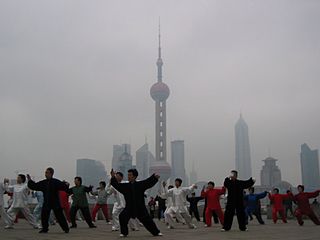
There are hundreds of different styles of Chinese martial arts, each with their own sets of techniques and ideas. The various movements in kung fu, most of which are imitations of the fighting styles of animals, are initiated from one to five basic foot positions: normal upright posture and the four stances called dragon, frog, horse riding, and snake.
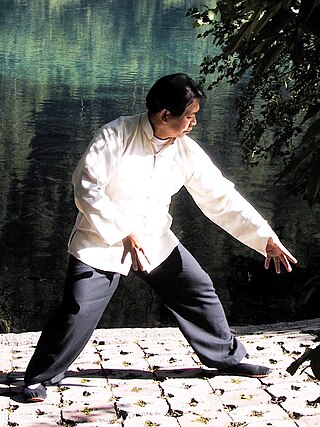
Qigong, is a system of coordinated body-posture and movement, breathing, and meditation said to be useful for the purposes of health, spirituality, and martial arts training. With roots in Chinese medicine, philosophy, and martial arts, qigong is traditionally viewed by the Chinese and throughout Asia as a practice to cultivate and balance the mythical life-force qi.

Li Luoneng (1807–1888) was a Chinese martial artist from Hebei province. He was also known as Li Feiyu, Li Nengran, Li Laonong, and Li Neng Jang, and was nicknamed "Divine Fist Li". He learned the internal martial art of Xinyiquan from Dai Wenxiong, son of Dai Long Bang, and later modified the style into Xingyiquan.
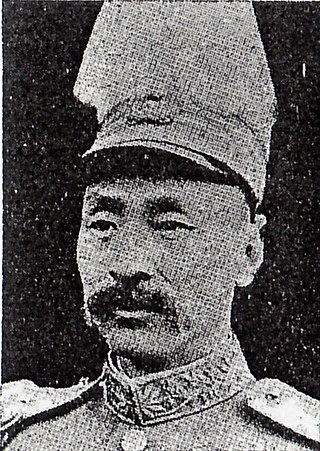
Li Jinglin, also known as Li Fangchen (1885–1931) was a deputy inspector-general and later army general for the Fengtian clique during the Chinese warlord era. He hailed from Zaoqiang County, Hebei province, China. After his military career was over he settled in Nanjing, and in 1927 moved to Shanghai. A renowned swordsman, he was known as "China's First Sword."

Wudangquan is a class of Chinese martial arts. In contemporary China, Chinese martial arts styles are generally classified into two major groups: Wudang (Wutang), named after the Wudang Mountains; and Shaolin, named after the Shaolin Monastery. Whereas Shaolin includes many martial art styles, Wudangquan includes only a few arts that use the focused mind to control the body. This typically encompasses tai chi, xingyiquan and baguazhang, but must also include bajiquan and Wudang Sword. Although the name Wudang simply distinguishes the skills, theories and applications of the internal arts from those of the Shaolin styles, it misleadingly suggests these arts originated at the Wudang Mountains. The name Wudang comes from a popular Chinese legend that incorrectly purports the genesis of tai chi and Wudang Sword by an immortal, Taoist hermit named Zhang Sanfeng who lived in the monasteries of Wudang Mountain. Wudang quan is often used synonymously with Neijia, but Neijia is a broader term that also encompasses Aikido and Qigong, which are not Wudang quan.
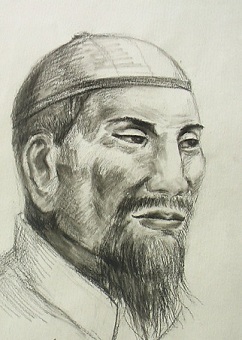
Ma Gui was an accomplished master of the internal Chinese martial art of Baguazhang, and was the first disciple of Yin Fu, who in turn was the first disciple of Baguazhang's founder Dong Haichuan. Various lines of Baguazhang claiming lineage to Ma Gui are still actively taught in China as well as in Japan, North America, and Europe.
Qigong, the Chinese practice of aligning breath, movement, and awareness for exercise, healing, and martial arts training, has a history that extends back more than 4,000 years. Contemporary qigong is a complex accretion of the ancient Chinese meditative practice xingqi or "circulating qi" and the gymnastic breathing exercise daoyin or "guiding and pulling", with roots in the I Ching and occult arts; philosophical traditions of Confucianism, Taoism, and Buddhism, traditional Chinese medicine and martial arts; along with influences of contemporary concepts of health, science, meditation, and exercise.
Wang Shujin (1904–1981), also known as Wang Heng Sun, was a Chinese martial artist, practitioner of the disciplines of baguazhang, taijiquan, and xingyiquan. He was one of the greatest promoters of those arts outside China, being their first teacher in Taiwan and Japan, and was particularly known for his challenges to other martial artists. Aside from his martial exploits, Wang was also a spiritual leader in the Taoist sect Yiguandao.
Du Xinwu, aka Ru Xia (儒侠), Dou Mi Guan Jushi (斗米观居士) was a Chinese martial artist and an important figure in the development of Zi Ran Men kung fu.
Wan Laisheng was a Chinese martial artist and author.